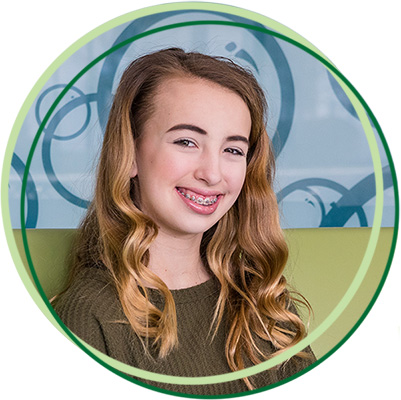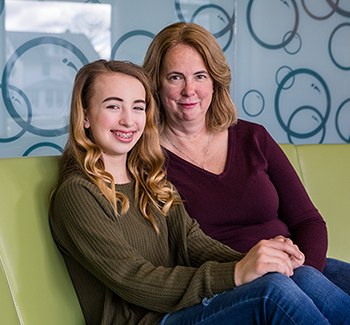Adrianna Disalvo
11-Year-Old Recovers from Rare, Life-Threatening Brain Hemorrhage
 It was 7:30 a.m. on Monday, April 30, 2018 when Barb Disalvo drove her daughter to school. Adrianna was an 11-year-old in the sixth grade. The morning trip had become routine, and this one began just like any other day. That would change within a few hours, when Barb received a phone call from the school nurse. Adrianna was in her office with nausea and complaining of a severe headache. Barb rushed back to the school immediately.
It was 7:30 a.m. on Monday, April 30, 2018 when Barb Disalvo drove her daughter to school. Adrianna was an 11-year-old in the sixth grade. The morning trip had become routine, and this one began just like any other day. That would change within a few hours, when Barb received a phone call from the school nurse. Adrianna was in her office with nausea and complaining of a severe headache. Barb rushed back to the school immediately.
Adrianna had a history of headaches and migraine headaches. She would develop a headache at least four to six times per month. But when Barb walked into the school nurse’s office that morning, she realized this was more than a headache. “Adrianna wasn’t responding. At first, we thought it was a food reaction, so we checked her locker and her book bag for any signs. We also talked to her friends. But Adrianna hadn’t done anything differently that day, and she was becoming less and less responsive,” said Barb. Eventually, Adrianna wasn’t responding at all, so they immediately called an ambulance.
Barb was still convinced Adrianna was suffering from a migraine, until Howard Silberstein, M.D., a pediatric neurosurgeon at Golisano Children’s Hospital, showed her the CT scan. Adrianna had a blood clot in her brain.
“They called me into the room and told me I needed to look at the scan, and while they had an idea as to what it was, they would have to do an angiogram in the morning to know for sure.” Adrianna was placed in intensive care. The next morning, the angiogram showed that Adrianna had an arteriovenous malformation (AVM) rupture that caused a hemorrhage in her brain. She would require surgery the next day. An AVM rupture is the consequence of an abnormal tangle of blood vessels leaking blood into the brain tissue.
As a consequence, the hemorrhage exerts pressure on the brain tissue, causing neurologic impairment. Left untreated, there can be subsequent strokes and recurrent hemorrhage. “It’s something we don’t see very often, and it can be very complicated to treat,” said Silberstein.
Staying Strong
Barb describes the turn of events on the morning of April 30 as surreal. “I dropped my child off perfectly healthy, made plans, and within four hours was told she has a blood clot in her brain. It’s very hard to describe where you go with your thoughts. One part of me knew I couldn’t fall apart because I had to remain focused on Adrianna so I knew how to handle everything. Another part of it is scary because of the unknown, thinking about how it will affect her, and how rare this is in children — especially in a girl.”
AVMs affect less than one percent of the population. In his 28 years of practice, Silberstein says AVMs continue to be rare. “It’s unpredictable to know how a patient will do.”
Adrianna would undergo surgery for nearly six hours. It would not be without complications. As the medical team prepped her the night before, Adrianna’s vital signs began to drop. Her pulse was dangerously low at 35. It took a team of nearly 10 physicians to stabilize her. Once she was stabilized, Silberstein and his surgical team were able to begin the complicated surgery. “We had to perform a craniotomy where we remove a portion of the skull and open the covering of the brain to remove the clot. We then had to find the AVM and take it out,” he said. The process of isolating and removing the AVM requires meticulous dissection and coagulation under the operating microscope.
 The Road to Recovery
The Road to Recovery
Adrianna didn’t wake up for two days. As she started coming to, her mom says she was slow in getting up and around. Barb also noticed a change in her personality. “She was a lot more withdrawn and easily overstimulated. We had to work through it.” Physical therapy helped Adrianna walk again. Soon, friends were visiting the energetic and vibrant girl they had come to know in school. “The last thing she remembered was being in gym class and then hearing a loud popping noise in her head,” recalled Barb.
After spending eight days in the hospital, Adrianna was ready to go home. She wasn’t allowed to do much because of the stitches, a challenge for a girl who is normally quite active. “Because she had been so healthy, though, doctors told me not to let her sit around so she wouldn’t get depressed.”
Soon, Adrianna returned to school on a part-time basis. The Adrianna that Barb knew before the surgery slowly began to reemerge. Six to eight months later, Adrianna’s personality returned to what it was before the AVM rupture. “To look at her physically, you would never know anything happened.” The only physical sign is a scar from one ear to the other.
Silberstein wasn’t completely surprised by Adrianna’s recovery. “Children in general make good recoveries.” In cases like this, most children or teens would also need brain rehabilitation. Adrianna wasn’t one of them. While AVMs can grow back, Silberstein says it’s unlikely. Last August, Adrianna had another angiogram that showed her brain was healing well. While her concentration in school isn’t quite what it used to be (at least for now), Adrianna is back to playing sports. She’s had only one migraine since the surgery and is due for another angiogram in May to confirm there has been no recurrence of her AVM.
Barb looks back at that “overwhelming” time in her life and is eternally grateful to the medical team that treated her youngest of four children. “Everything we experienced at the hospital was amazing, from the one-on-one care with nurses to the doctors who took the time to stop to listen and answer our questions.”
While children are known for their resilience, Silberstein says it’s also the strength of a family that can determine a positive outcome. “They were a great family to work with. They were very appreciative of the care and attention Adrianna was getting and they asked good questions. They put their faith in our team.”
Make a Gift to Golisano Children's Hospital